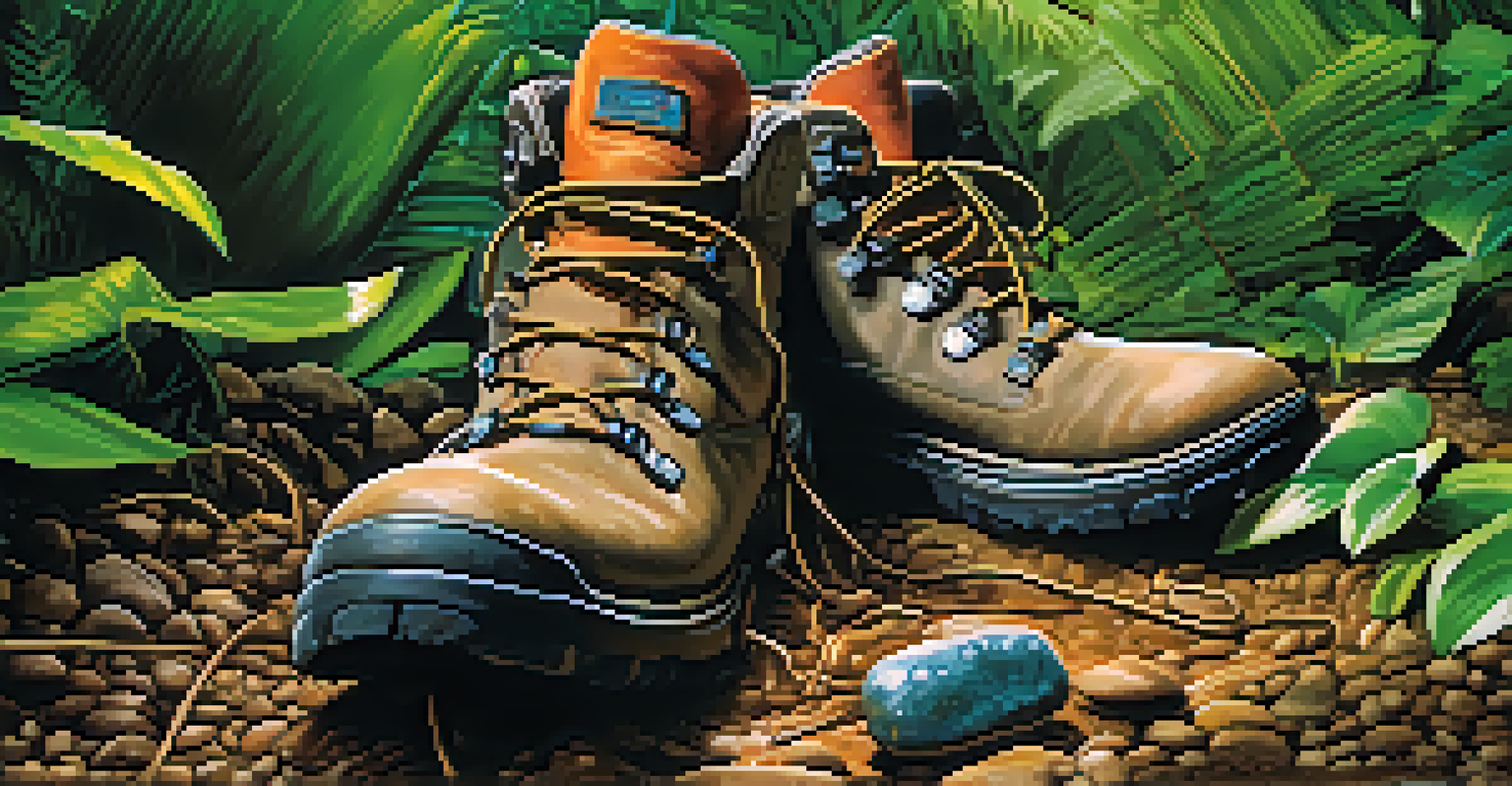Guide to Choosing the Right Footwear for Peruvian Trails

Understanding the Terrain of Peruvian Trails
Peruvian trails offer a diverse landscape, from rugged mountains to lush valleys. Understanding the terrain is crucial when selecting the right footwear. Different trails may have rocky paths, muddy sections, or steep inclines, each presenting unique challenges.
The journey of a thousand miles begins with one step.
For instance, the Inca Trail features uneven stones and steep steps, while the Amazon region may have slippery, wet conditions. Recognizing these differences can help you choose footwear that provides the right support and grip. A well-informed choice can significantly enhance your hiking experience.
Consider the specific trail you plan to tackle, as this will guide your footwear selection. By matching your shoes to the terrain, you'll be better prepared to enjoy the stunning views without worrying about discomfort or injuries.
Key Features to Look for in Hiking Footwear
When choosing footwear for Peruvian trails, look for features that enhance comfort and safety. Key elements include durability, water resistance, and proper cushioning. These features will ensure your feet are protected against the elements and rough terrain.

Additionally, tread patterns play an important role in traction. A good grip is essential, especially on steep or slippery surfaces. Don't forget to consider breathability too; your feet will appreciate it during long hikes in warmer weather.
Choose Footwear for Trail Conditions
Selecting the right footwear based on the terrain, such as rocky paths or wet conditions, is essential for a comfortable hiking experience.
Ultimately, the right features will help you focus on the journey rather than discomfort. Prioritizing these essential characteristics can make a world of difference on your adventure.
Choosing Between Hiking Boots and Trail Runners
One of the biggest decisions is whether to opt for hiking boots or trail runners. Hiking boots provide excellent ankle support and are ideal for challenging terrains, making them a popular choice among serious hikers. They are usually more durable and offer better protection against rocks and debris.
There is no such thing as bad weather, only inappropriate clothing.
On the other hand, trail runners are lightweight and offer greater flexibility, which can be advantageous for those who prefer a faster pace. They often dry quickly, making them a smart choice for wetter trails. However, they may lack the support needed for longer hikes or rough terrain.
Ultimately, the choice depends on your hiking style and the specific trails you plan to explore. Consider your personal comfort and the level of support you need to make the best decision.
The Importance of Fit When Selecting Footwear
Fit is everything when it comes to hiking footwear. A well-fitting shoe can prevent blisters, calluses, and other discomforts that can cut your adventure short. It's crucial to try shoes on with the socks you plan to wear and walk around to ensure they feel right.
Keep in mind that your feet may swell during long hikes, so consider trying on footwear later in the day. Look for a snug fit without being too tight, and ensure there’s enough room in the toe box to wiggle your toes. A proper fit will enhance your stability and comfort on the trails.
Fit is Crucial for Comfort
A proper fit in hiking footwear helps prevent discomfort and injuries during long hikes, ensuring stability and support on the trails.
Don't hesitate to consult with knowledgeable staff at outdoor retailers. They can provide insights and suggestions to help you find the perfect fit for your hiking needs.
Testing Footwear Before Your Trip
Before heading to the Peruvian trails, it's wise to test your footwear. Take short hikes or walks around your local area to break them in and ensure they perform well. This practice helps identify any potential issues before you embark on your adventure.
Pay attention to how your feet feel during these tests; discomfort is a red flag. If blisters or aching occur, it may be time to reassess your choice. A few trial runs can save you from significant pain on longer treks.
Additionally, consider testing your footwear in similar terrains to those you’ll encounter in Peru. This will give you a better idea of how they’ll perform and help you build confidence in your gear.
Maintaining Your Footwear for Longevity
Proper maintenance of your footwear can significantly extend its lifespan. After each hike, clean off dirt and mud to prevent damage to materials. Allow your shoes to dry naturally—avoid direct heat sources, which can warp or damage them.
Regularly check for wear and tear, such as frayed laces or worn-out soles. Addressing these issues early can prevent more significant problems down the line. Consider applying waterproofing treatments if your shoes are designed for it, especially if you plan to hike in wet conditions.
Test and Maintain Your Shoes
Testing your footwear before your trip and maintaining it regularly can enhance performance and prolong its lifespan.
Remember, well-maintained footwear not only lasts longer but also performs better, keeping you comfortable and safe on the trails.
Packing Extra Footwear for Your Adventure
While your primary footwear is crucial, packing an extra pair can be a lifesaver. A second pair of shoes allows your feet to recover after a long day of hiking. It can also come in handy for relaxing at camp or navigating through towns.
Consider opting for lightweight sandals or shoes that are easy to slip on and off. This way, you can give your hiking boots a break while still being comfortable. Plus, having a backup can save you from discomfort if your main pair gets wet or damaged.

Ultimately, being prepared with extra footwear adds an extra layer of comfort to your outdoor experience, allowing you to enjoy your adventure to the fullest.